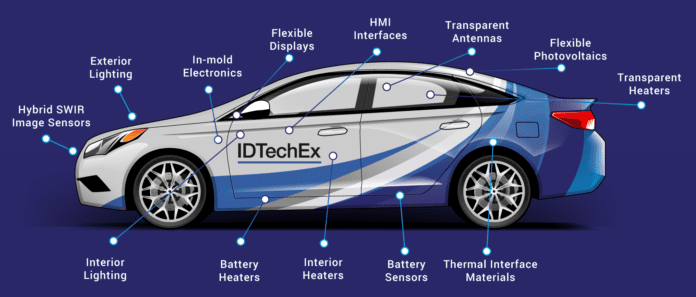Automotive OEMs have always added features to differentiate their vehicles, either from other brands or from other models in their product range. Traditionally this was done primarily by changing the engine parameters, for example increasing the displacement, using more cylinders, or adding a turbocharger.
However, these options for differentiation are substantially curtailed in EVs. Most consumers can’t distinguish between different motor or inverter designs, so the only distinguishing factors are range, horsepower, and possibly charging rate.
As such, manufacturers are increasingly using interior features to distinguish between models and from other brands. This transition is eloquently expressed in the quote from the president of a gauge cluster/cockpit manufacturer: “The cockpit is where the battleground has now shifted. It’s no longer what is under the hood, but what’s inside the cockpit.” There are, therefore, extensive opportunities for printed/flexible electronics to add additional functionality to the cockpit while facilitating efficient manufacturing, as outlined in the recently released IDTechEx report “Printed and Flexible Electronics for Automotive Applications 2021-2031: Technologies and Markets”. Examples include adding more and higher performance displays, innovative control interfaces, and generally improving the aesthetic with organic curves and integrated functionality.
Interior displays multiply
The increasing number and size of color displays in automotive interiors is clearly apparent, with the recently launched Honda-E having six just for the front seat passengers. Display placement goes beyond the conventional center screen and digital gauge clusters to include displays for mirrors and passenger entertainment. OLEDs are likely to be increasingly adopted, as the resolution and color gamut meet the expectations consumers transfer from their smartphones. Conformality should also enable a wider range of integration opportunities, such as safety improving ‘transparent’ pillars.
Smart surfaces and IME
No discussion of automotive interior trends is complete without mention of smart surfaces, in which capacitive touch sensors and lighting integrated within interior panels replace mechanical switches. The technology driving this transition is in-mold electronics (IME), in which electronic, decorative, and mechanical features are combined in a single component. This is achieved by screen printing conductive traces and mounting simple SMD components onto a film, thermoforming, and then finally injection molding.
IME enables multifunctional components such as center consoles and overhead control panels to be much lighter, simpler, and easier to manufacture. An additional benefit is the decoupling of structural and electronic/decorative functionality, thus making ‘versioning’ more straightforward since the same molds for thermo and injection molding can be used to make parts with varying appearance and functionalities. Furthermore, IME enables new use cases, such as adding electronic and touch-sensitive functionality into the backs of the front seats, with some automotive OEM design teams having identified over 40 distinct use cases.
Smart surfaces are also likely to evolve to offer more sophisticated interactions than simple capacitive sensors or on/off buttons. For example, printed pressure sensors are likely to find their way into control panels, thus providing a wider range of inputs. Haptic feedback is also likely to become widely integrated since positive actuation is both more satisfying to use and arguably safer if it minimizes the need for the driver to take their eyes off the road.
Printed/flexible interior heaters
The existing approach to heating car interiors by blowing hot air around is very inefficient and highly detrimental to the range of electric vehicles. Printed/flexible electronics to incorporate heaters within touchpoints is significantly more efficient – as such this approach is likely to be extended beyond seats and steering wheels to encompass armrests and center consoles. Furthermore, the conformality of printed electronics enables heaters to be placed much closer to the surface, making heating more efficient and responsive. Transparent conductors take this idea a step further and can be applied just under the surface of materials, enabling them to be combined with lighting elements.
Comprehensive overview
In summary, there are extensive opportunities for printed and flexible electronics within automotive interiors, with a key driver being an increased focus on this area for differentiation by the manufacturers. IDTechEx’s new report “Printed and Flexible Electronics for Automotive Applications 2021-2031: Technologies and Markets” outlines the current status and opportunities for printed/flexible electronics across 11 application areas, along with 10-year printed electronics automotive market forecasts by revenue and volume, multiple application case studies and assessments of commercial and technological readiness. The report also includes multiple company profiles based on interviews with early-stage and established companies, along with 10-year market forecasts. Further details and downloadable sample pages can be found at www.IDTechEx.com/PEAuto. For the full portfolio of Printed and Flexible Electronics research available from IDTechEx please visit www.IDTechEx.com/Research/PE.
About IDTechEx
IDTechEx guides your strategic business decisions through its Research, Subscription and Consultancy products, helping you profit from emerging technologies. For more information, contact research@IDTechEx.com or visit www.IDTechEx.com.
Help keep news FREE for our readers
Supporting your local community newspaper/online news outlet is crucial now more than ever. If you believe in independent journalism, then consider making a valuable contribution by making a one-time or monthly donation. We operate in rural areas where providing unbiased news can be challenging. Read More About Supporting The West Wales Chronicle





















